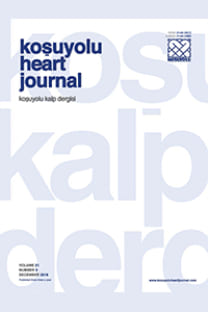Extraction of a Proximal Portion of a Fractured Lead Using a Bulldog Lead Extender in a Patient with Recurrent Septicaemia Following Incomplete Removal of Pacemaker Leads
Endocarditis, pacing, pacemakers,
___
- 1. Vilacosta I, Zamorano J, Camino A, San Roman JA, Rollan MJ, Pinto A, et al. Infected transvenous permanent pacemakers: role of transoesophageal echocardiography. Am Heart J 1993;125:904-6.
- 2. Klug D, Lacroix D, Savoye C, Goullard L, Grandmougin D, Hennequin JL, et al. Systemic infection related to endocarditis on pacemaker leads. Circulation 1997;95:2098-107.
- ISSN: 2149-2972
- Yayın Aralığı: 3
- Başlangıç: 1990
- Yayıncı: Ali Cangül
Mustafa YILDIZ, Ahmet Çağrı AYKAN, Banu ŞAHİN YILDIZ, Gönenç KOCABAY
İlker GÜL, Mustafa ZUNGUR, Ahmet Çağrı AYKAN, Aysel İSLAMLI, Bekir Serhat YILDIZ, Murat BİLGİN
Ankaferd® Kanama Durdurucunun Rat Abdominal Aort Kanama Modelinde Kanama Zamanına Etkisi
Oruç Alper ONK, Mehmet AKSÜT, Fatih ÖZÇELİK, Didem ONK, Erdim SERTOĞLU, Hüseyin Serkan EROL, Ümit KAHRAMAN, Osman Nuri TUNCER, Ömer YİĞİNER, Bilgehan ERKUT
Popliteal Artery Entrapment Syndrome with Atypical Claudication and Popliteal Artery Aneurysm
Mehmet ÇAKICI, Evren ÖZÇINAR, Fatih ADA, Adnan UYSALEL, Bülent KAYA, Mustafa Bahadır İNAN, Mehmet TAŞAR, Sadık ERYILMAZ
Mehmet Ali ASTARCIOĞLU, Taner ŞEN, Halil İbrahim DURMUŞ, Muhammed OYLUMLU, Celal KİLİT, Basri AMASYALI
Sağ Ana Femoral Arterin Gerçek Anevrizması Sunumu
Muhammet Onur HANEDAN, Mehmet Ali YÜRÜK, Tanıl ÖZER, Uğur ZİYREK, İlker MATARACI
Burçin ABUD, Yücel KARAMAN, Cengiz ÖZBEK, Kemal KARAARSLAN, Soysal TURHAN
Burçin ABUD, Cengiz ÖZBEK, Soysal TURHAN, Kemal KARAARSLAN, Yücel KARAMAN
The Mystery Hidden by Pulmonary Embolism: Colonic Adenocarcinoma
Mithat SELVİ, Sevil ÖNAY, Tarkan TEKTEN
İlker GÜL, Ahmet Çağrı AYKAN, Mustafa ZUNGUR, Murat BİLGİN, Bekir Serhat YILDIZ, Aysel İSLAMLI
